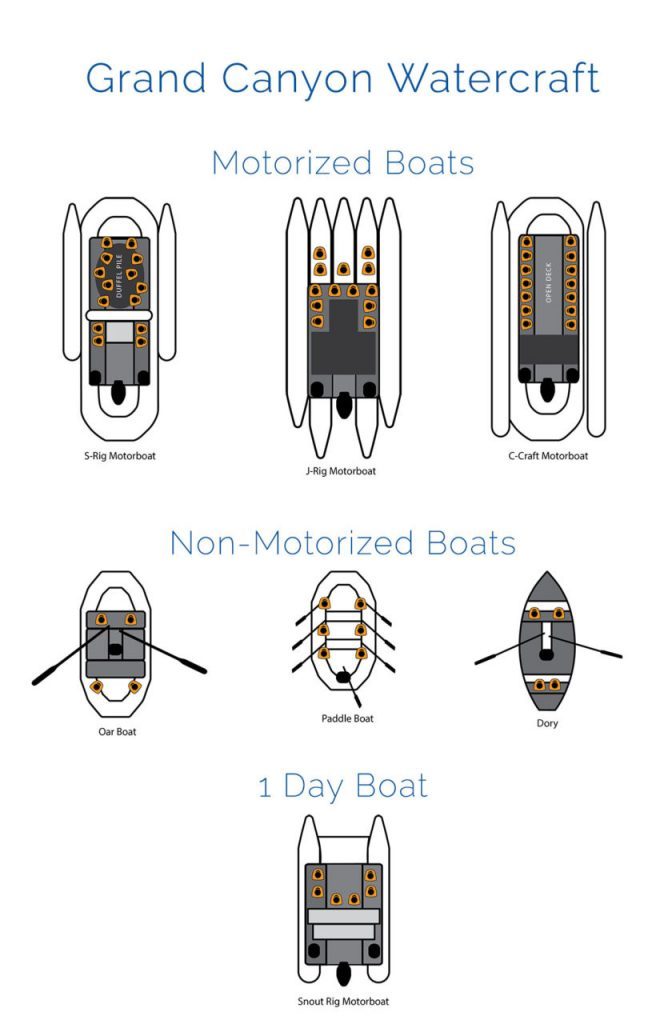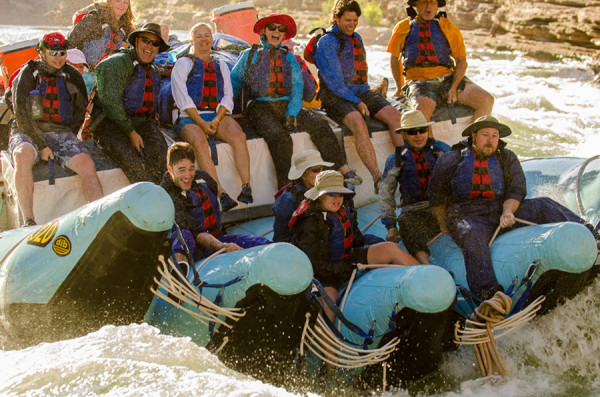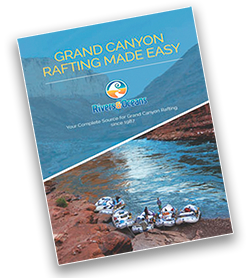
Types of Rafts
Grand Canyon Rafting
One of the first questions to figure out for rafting the Colorado River is which types of rafts are best. We’ve written this blog to help you understand the different whitewater crafts that are run commercially and how they change the experience of floating the Grand Canyon.
Motorized versus Non-motorized Rafts
A starting point for many when deciding upon a Grand Canyon trip is choosing between motor-powered craft and non-motorized craft. We are often asked which experience is better, a motor trip or non-motorized. Our answer is the ever so annoying, “it depends.” It depends on what type of experience you are looking for, how much time you can spend in the Canyon, your physical capabilities and the age of your children (if any). Each type of craft provides a unique experience but ultimately they all provide the most important thing: passage into one of the world’s most scenic stretches of river. Read more about Non-motorized versus motorized rafting trips.

Find Your Grand Canyon Rafting Adventure…

Find Your Trip
Request a trip search, we’ll find tours meeting your criteria.
*** Our service is free to you and paid for by our partner outfitters. We guarantee the same price as booking directly with the outfitter.
Motor Rafts
Pioneered by Georgie White, motorized rafts provide Grand Canyon’s most popular rafting tour. Since 2012, the National Park Service Management Plan has these and all motor trips limited to a maximum of 28 guests and 4 guides. A fully booked motor trip will have two motor rafts with 14 guests and up to 2 guides on each boat. The motorboat trips have many positive aspects that people don’t often consider right away.
- They provide increased river accessibility to the public, including children, elderly, and people with disabilities. Although many of these people can and do travel by oar boat, motorboats are especially handy. They provide the extra buffer of a larger boat, less likelihood of flipping, and more storage space for special requests and needs.
- Motorized rafts travel approximately twice as fast as an oar-powered boat. You can run the full length of the Canyon in a little over half the time (6 to 8 days). Handy for people with limited vacation times.
- A large group can generally all sit together on the same boat and share the experience.
- Although outboard motors emit a loud noise, the sound is muffled by the rubber boat and the water. Passengers can easily be in any of the designated seating areas on a motor boat and have a normal conversation with the person sitting next to them. The person who will be most impacted by the sound of the motor will be your guide. However, they are always accessible to you and will motor down to answer any questions in addition to all of the planned floats where the motor is cut for Grand Canyon interpretive programs.
- Even though they are much bigger than the human powered rafts, rafters still get soaked in the rapids. These boats are actually a little cooler to ride on then traditional rafts due to the breeze from moving so quickly down river.
Specific types of motor rafts in Grand Canyon
“S-Rig”
An S-Rig motorboat is typically 25-30 feet long and can carry up to 14 passengers and 2 guides. The center of the boat is a large, oblong donut shaped pontoon with two shorter side pontoons strapped on either side for stability. Guests sit on decks or boxes that encircle a large duffel pile of dry bags with their feet resting—or braced in big whitewater—on the side pontoons. As with all the motorboats, the guide stands at the back of the boat in the motor-well where they operate a four-stroke outboard motor.

“C-Craft”
A C-craft is around 34 feet long and can carry 14 guests and 1-2 guides. These boats are designed with an open deck that runs down the center of the boat. This allows for standing and moving about the boats at an easier access. There are multiple seating options with these crafts, never on the bag pile. During larger rapids guests sit down on the decks in the “down and in” position. As with all the motorboats, the guide stands at the back of the boat in the motor-well where they operate a four-stroke outboard motor.

“J-Rig”
The J-Rig ranges from 32-37 feet long and has the capacity to carry 15-20 passengers and up to 2 guides. The boat design is five pontoons lashed together. The seating configuration can vary between outfitters as shown in the pictures. As with all the motorboats, the guide is at the back of the boat running a four-stroke outboard motor. The rafts are also run at high water on 4-day Cataract Canyon trips.

“Snout Rig”
Originally, the 22-foot snout rafts were run as oar boats. Today, they run the one-day section from Diamond Creek to Pearce Ferry and 2-day Cataract Canyon trips. They have one guide plus 8 to 10 passengers. They are the sports car of motor rigs.

Non-Motorized Types of Rafts
Fully booked non-motorized trips will average between 18 and 24 people with a guide to operate each boat. Generally speaking a trip will have 6-8 boats and the same number of guides. Here are some other aspects of non-motorized types of rafts that I love:
- Whether you are sitting on an oar boat, paddle boat, or dory, you will be a part of the whitewater experience. Your guides will ask you to lean into the big water, adding stabilizing weight as the boat crests over a big wave. You will learn the term “high side” on your first whitewater orientation: a call for all passengers to move their weight to the “high side” of the boat to keep it from flipping. Dory riders need to bail water after rapids. Paddlers work together and follow their guide’s instructions in order to get downstream. The whitewater experience is inherently participatory.
- Non-motorized boats offer the gift of absolute quiet, allowing you to hear the riffles and the birds. They also sit much lower on the water letting guests simply reach down to touch the river’s surface. The serenity of a boat floating at the river’s pace is the perfect time to absorb the glory of the Canyon.
- Because non-motorized boats have limited capacities, often times parties have to split and mix with the rest of the group. This cultivates more community and allows for more of a variety as each raft is a different experience.
Specific types of non-motorized boats in Grand Canyon

Oar Rafts
These rafts carry up to 4 guests and 1 guide. The guide is 100% responsible for navigating the boat however, many guides will allow you to try rowing the flat water and smaller rapids. Made of rubber or plastic materials, inflatable. Oar boats are fairly stable and comfortable for lounging.
Dory
Dories carry up to 4 guests and 1 guide. The guide is 100% responsible for navigating the crafts. These boats are made of fiber glass and/or wood, hard hulled. Dories are higher performance craft than rafts so they are a fun ride on top of the water but flip more easily. Most people find them less comfortable to sit in than rafts.

Paddle Raft
Paddle rafts carry 6 guests and 1 guide. The guests are 100% responsible for propelling the boat while the guide navigates the boat from the stern. These inflatable boats are made of rubber or plastic materials.

Types of Rafting Trips
While motorized rafting trips may have more than one motor raft type on the trip there is typically a maximum of 2 rafts. Non-motorized raft trips have many more options: all paddle, all oar, and hybrid.
All Paddle, All Oar, Dory Trips
These trips are self explanatory either all the guests ride in oar rafts, dories or they all ride in paddle rafts. On an all paddle trip or dory trip there are support oar rafts that just carry gear. These trips are for people who want to either paddle every day or don’t want to paddle at all or want to ride in a dory for their entire trip.
Hybrid Trips
Grand Canyon hybrid trips have a mixture of raft types. Most hybrid trips will have 5 oar rafts and then one paddle raft. People will take turns riding in the paddle raft either switching by day or half day. We find many people think they are going to want to only paddle or never paddle however when they go on a hybrid trip they realize they prefer the other type of craft. Hence, we typically recommend hybrid trips over the all oar or all paddle.

Hybrid Trips with a Dory
Some companies are starting to bring a dory on their hybrid trips so there are 4 oar rafts, a dory, and a paddle raft. This combination works well as it allows people to try out a dory but doesn’t have the issues of an all dory trip where they can only stop at certain attractions and camps due to needing special parking spots for all the dories.
Concluding Thoughts on Raft Types
While each raft is unique we find no matter which craft you ride down the Colorado River the trip is memorable. If you have any questions please give us a call or read our PDF on whitewater crafts. We love talking about all aspects of Grand Canyon river trips.
Looking for more reading check out our Grand Canyon rafting overview, this article on when to raft the Grand Canyon, or learn about Lava Falls rapid, the biggest rapid in North America.
Interested in Rivers & Oceans finding available Grand Canyon rafting trips for you, request a trip search or ask us any questions. Our service is free and covered by the outfitters. We guarantee the same rate as you would pay going directly with an outfitter. One call to us gets you availability for 16 Grand Canyon rafting companies.







